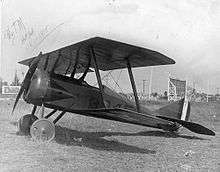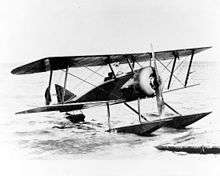Thomas-Morse S-4
| S-4 | |
|---|---|
.jpg) | |
| S-4C Scout | |
| Role | advanced trainer |
| National origin | United States |
| Manufacturer | Thomas-Morse Aircraft |
| Designer | Benjamin D. Thomas |
| First flight | June 1917[1] |
|
| |
The Thomas-Morse S-4 Scout was an American biplane advanced trainer, operated by the United States Army and the United States Navy. Dubbed the "Tommy" by pilots who flew it, the aircraft became the favorite single-seat training airplane produced in the U.S. during World War I. It had a long and varied career beginning with the S-4B, which first appeared in the summer of 1917.[2]
Design and development
Built by Thomas-Morse Aircraft in Ithaca, New York in 1917, it was a compact single-seat open-cockpit biplane of equal span and a 100 hp (75 kW) Gnome rotary engine.[3]
The S-4 was designed by Englishman Benjamin Douglas Thomas (no relation to the company owners),[4] formerly with the Sopwith Aviation Company,[5] who also assisted with the design of the Curtiss JN-4 Jenny.[6] The S-4 made its maiden flight in June 1917 in the hands of Paul D. Wilson.[4] Twelve planes went to the Navy.[4]
Operational history


The S-4B, with a 110 hp Gnome, a span of 27’ (8.22 m), and length of 20’3” (6.17 m)[4] proved more successful, with three prototypes followed by an order of 97 for the Army and 10 for the Navy,[4][7] while six more were completed with two main and one tail floats as the Navy S-5.[3][8] The S-4B was used by practically every pursuit flying school in the U.S. during 1918.[2]
It was supplemented in 1918 by the S-4C, at a cost of US$5400 each.[4] Six prototypes were built,[4] and the 80 hp (60 kW) Gnome B-9 was replaced by the "more reliable" 80 hp (60 kW) Le Rhône C-9 starting with the fifty-second production aircraft.[3][4] 461 S-4Cs went to the Army and four S-4Cs with floats went to the Navy.[4]
After World War I, many "Tommys" were sold as surplus to civilian flying schools, sportsman pilots, and ex-Army fliers. Many were still being used in the mid-1930s for World War I aviation movies, and several continue to exist in flying condition today.[2]
A single aircraft was fitted with new tail and 110 hp (82 kW) Le Rhône, becoming the S-4E aerobatic trainer.[3] It was not adopted by the military, and after being fitted with a 135 hp (101 kW) Aeromarine V8 engine, it became Basil Rowe‘s racer Space-Eater.[4]
About sixty surplus aircraft survived in civil service, most of which were fitted with the Curtiss OX-5.[4]
Operators
Survivors
- One surviving Thomas-Morse S-4B, possibly the last example produced, is currently on static display in the Old Rhinebeck Aerodrome's main display hangar.
- An S-4B is being restored by the Ithaca Aviation Heritage Foundation. The current plan, when restoration is complete, is to display it in the original factory building where it was produced.[9][10]
- Another S-4B is on display inside the National Museum of the Marine Corps.[11] This aircraft has original S-4B wings mounted on a reproduction B-fuselage, which was fabricated using parts from the prototype S-4.[10]
- One is awaiting restoration at Fantasy of Flight in Polk City, Florida. While the model is not identified, it is fitted with the Gnome engine,[12] implying this may be an S-4B.
- In Dayton, Ohio, an S-4C "Scout" is displayed in the National Museum of the United States Air Force's Early Years Gallery that was restored by students at the Aero Mechanics High School in Detroit, Michigan.[13]
- One S-4C, configured to represent the S-5 floatplane variant, resides at the National Naval Aviation Museum in Pensacola, Florida.[14]
- One S-4C resides at Yanks Air Museum in Chino, California, at the Chino Airport.[15]
- Two S-4Cs are under restoration at the Pioneer Flight Museum in Kingsbury, Texas. The first is considered flyable, but is undergoing restoration. The second is also being restored, albeit at a lesser priority.[16] One is planned to be marked with US World War I roundels and the other with the USAAS' star and red disc insignia.
- The Cradle of Aviation Museum in Garden City, New York, has an S-4C, equipped with its original Marlin machine gun, on display.[17] Additionally, they possess an uncovered Scout fuselage, possibly from one of the prototypes, fitted with a LeRhone engine and a working gun synchronizer.
- One S-4C resides at the Eagles Mere Air Museum in Eagles Mere, Pennsylvania.[18]
- One S-4C is displayed at the EAA AirVenture Museum in Oshkosh, Wisconsin.[19]
Specifications (S-4C, late production)

Data from Aerofiles, United States Navy Aircraft since 1911,[4][7]
General characteristics
- Crew: 1
- Length: 19 ft 10 in (6.05 m m)
- Wingspan: 26 ft 6 in (8.08 m)
- Height: 8 ft 1 in (2.46 m)
- Gross weight: 1,330 lb (605 kg)
- Powerplant: 1 × Le Rhône 9C air-cooled rotary, 80 hp (60 kW)
Performance
- Maximum speed: 97 mph (156 km/h)
- Endurance: 2 hours 30 min
- Service ceiling: 15,000 ft (4,500 [20] m)
Armament
- Optional .30 caliber Marlin machine gun
See also
- Aircraft of comparable role, configuration and era
- Related lists
References
- Notes
- ↑ Holmes, 2005. p 52.
- 1 2 3 United States Air Force Museum 1975, p. 10.
- 1 2 3 4 Donald 1997, p. 875.
- 1 2 3 4 5 6 7 8 9 10 11 12 "Thomas." Aerofiles.com. Retrieved April 8, 2008.
- ↑ Angelucci 1973, p. 41.
- ↑ "Thomas-Morse S-4 Scout". The Aviation History Online Museum. Retrieved November 29, 2016.
- ↑ Hooker, Chris (December 27, 2014). "Restored Thomas-Morse Plane Takes Shape". Ithaca Times. Retrieved 1 December 2016.
- 1 2 Rundle, Jim; Funke, Don. "Differences Between the Thomas Morse S-4B and S-4C: Lessons and Questions From an Ongoing Restoration (Part 1)" (PDF). Tommy Come Home. Ithaca Aviation Heritage Foundation. Retrieved November 29, 2016.
- ↑ "World War I". Exhibits. National Museum of the Marine Corps. Retrieved November 29, 2016.
- ↑ "1918 Thomas Morse Scout". Aircraft Currently NOT Showing in Museum. Fantasy of Flight. Retrieved November 29, 2016.
- ↑ "Thomas-Morse S4C Scout". Museum Exhibits Fact Sheets. National Museum of the USAF. Retrieved November 29, 2016.
- ↑ "S-4C Scout". Aircraft and Exhibits. National Naval Aviation Museum. Retrieved November 29, 2016.
- ↑ "Thomas-Morse Scout". Yanks Collection. Yanks Air Museum. Retrieved November 29, 2016.
- ↑ "Aircraft of the Pioneer Flight Museum". Pioneer Flight Museum. Retrieved November 29, 2016.
- ↑ "Thomas Morse S4C Scout". Permanent Exhibits. Cradle of Aviation Museum. Retrieved November 29, 2016.
- ↑ "The Aircraft Collection". Eagles Mere Air Museum Foundation. Retrieved November 29, 2016.
- ↑ "1918 Thomas-Morse Scout S4C - N38899". EAA Museum Collections. Experimental Aircraft Association. Retrieved November 29, 2016.
- ↑ Angelucci 1983, p. 85.
- Bibliography
- Angelucci, Enzo, Great Aeroplanes of the World. London: Hamlyn, 1973.
- Angelucci, Enzo. The Rand McNally Encyclopedia of Military Aircraft, 1914–1980. San Diego, California: The Military Press, 1983. ISBN 0-517-41021-4.
- Donald, David, ed. Encyclopedia of World Aircraft, p. 875, "Thomas Brothers and Thomas-Morse aircraft". Etobicoke, Ontario: Prospero Books, 1997.
- Holmes, Tony. Jane's Vintage Aircraft Recognition Guide. London: Harper Collins, 2005. ISBN 0-00-719292-4.
- Strnad, Frank. The Thomas Morse Scout. London: Profile Publications, 1966.
- Swanborough, Gordon and Bowers, Peter. United States Navy Aircraft since 1911. London:Putnam, Second edition, 1976. ISBN 0-370-10054-9.
- United States Air Force Museum. Wright-Patterson AFB, Ohio: Air Force Museum Foundation, 1975.
External links
| Wikimedia Commons has media related to Thomas-Morse S-4. |
- Aerofiles
- Thomas-Morse S-4 (history, photos, three-view, and paper model)
- Old Rhinebeck Aerodrome's Thomas-Morse S-4B page